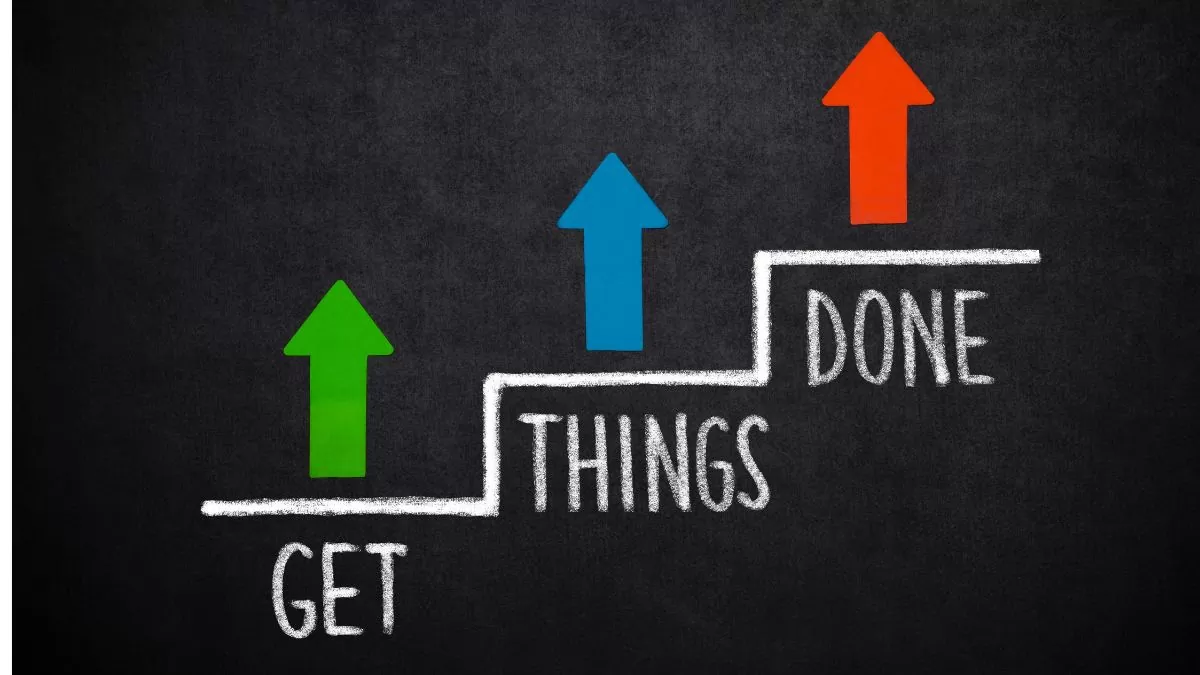
Getting Things Done
Author – David Allen
The End of Stress
Your brain is great at thinking, but terrible at remembering things.
Workflow:
- Capture your thoughts. Instead of keeping all those ideas, to-dos, decision, and so forth in your head, you need to capture them in some external platform. Whether on paper or digitally.
- Clarify what each item is and what you can do with it.
- Organize the outcomes into a structure of lists.
- Reflect on what is important to you and review the items in your system.
- Engage your tasks. Pick which action you wish to undertake at this time and do it.
To fully implement the GTD system, you need the right workplace, tools and filing system.
Set up a workplace for yourself where all relevant material are available.
Set up identical workspaces at home and in the office, so you can be equally effective in both.
If you spend a lot of time in transit, you may want to think about a mobile setup that lets you get things done even while on the road.
Never share workspaces with anyone, not even your partner.
You don’t want to have to spend time setting up your workspace to your liking every time you arrive at it.
Purge your files at least once a year to avoid the system becoming a bloated mess.
Capture all your tasks, ideas, reminders and more in trusted external collection tools.
Clarify:
empty all your external collection tools weekly.
Clarify what each item is and organize the items into the right places.
Start by looking at each item in your collection tools and simply asking yourself: “what is it?”
The most important thing to ascertain here is where the item is actionable or not.
If the item isn’t actionable, there are only 3 possibilities:
- It’s no longer needed, meaning it’s trash.
- No action is needed right now, but you may need to do something about it later. An example would be an invitation to a future event that you’re not sure if you’ll be able to attend.
- It’s information that you may need later, like the budget for a project you plan to undertake.
If it takes several actions to attain this outcome, then this is a project.
You then need to ask yourself what the next action for this item or project is.
Once you’ve identified something as a next action, you have 3 options:
- If the action takes less than two minutes to complete, do it immediately, before moving to the next item. It will actually be more time-consuming to store and organize such small items than to just do them right away.
- If the action takes longer than two minutes, think about whether you’re the right person to do it. If not, delegate it to the right person.
- If you are the right person to perform the action, but it would take longer than two minutes, defer it.
Organize
empty your collection tools and put things in the right place.
If an item is:
- actionable and attaining the desired outcome takes more than one step, it is a project and goes onto your Projects list. Projects can vary greatly in size.
- A single action that you delegate to someone else, it should go on a Waiting For list, like if you need to go hear from a contractor before choosing tiles for your bathroom.
- A single action that you defer, you have two new choices: either it goes into your Calendar or onto a Next Action list.
- Your Calendar is meant for a time-specific or date-specific actions or information, like “Dentist appoint 9 AM”
- Next Action lists are where all your to-dos end up. Since it’s not practical to have one long list with hundreds of items, you can split these lists up by context. Ex: “Email Jeff” and “Google Design Theory” could go onto an On the Computer list, whereas calls to be made could be assigned to an On the Phone list.
If an item:
- is not actionable, but you may need to do something about it later; it goes onto a Someday/Maybe list, which is reserved for items that you don’t want to engage in right now but also don’t want to forget about, like “Learn Spanish” or “Fix outdoor doorbell”. You can also have similar lists with more specific topics, like “Moves to watch” or “Books to read”.
- Might become useful reference information later, it goes into storage as reference material. This could mean sticking a take-out menu from your favorite restaurant into your filing cabinet, or saving a performance review from your boss onto your hard drive.
Use a Projects list to keep track of your current projects and always insist on clear next actions.
Project → desired result that necessitates taking more than one action step.
Always insisting on defining a physical, visible next action can be a profoundly powerful habit that sets your projects moving forward at surprising speed.
What’s the next action?
Once you’ve identified an action to take, it should be stored in your Calendar or Next Action lists.
Natural planning method:
- purpose and principles
- outcome visioning
- brainstorming
- organizing
- identifying next actions
- Purpose and Principles
Begin by identifying why you’re undertaking a project. What’s its purpose? For example, why do you need to create a business plan? If the reason is to secure funding, then you know how to craft it with investors in mind. Next, try to nail down another foundation of your project: the principles you care about. Perhaps, for instance, you have the principle that your team must not feel overworked, or that the outcome must be ethically as well as financially sound. Acknowledging these boundaries early in the process will make it easier to work within them. - Outcome Visioning
Envision the outcome you wish to attain by asking yourself what the project will look like when it’s done. An example of a well-defined outcome could be to increase your company’s sales by 5 percent. Defining the goal in this way helps you focus on it, and the focus will help you attain it. - Brainstorming
Brainstorm ideas for how to get there. Once you understand your goal, ideas will automatically start popping into your head. Don’t stop to judge them yet, just let them flow freely, but be sure to capture all of them. In true brainstorming fashion, go for quantity, not quality. This maximizes the chances that some of the ideas you come up with will be good. - Organizing
Organize your ideas. Identify the most significant ones and sort them. Possible ways to sort are either by which things naturally belong together, the order things need to happen, or according to prioritize. For instance, you may group together all the ideas connected with market research, or all the ones that need to be clarified before the others can even be considered. - Identifying Next Actions
Define the next physical, visible action that will move the project forward. If your project has many components, ask yourself for each whether you or someone else could be doing something about it now, and create next actions based on it. For instance, if your project is to grow your revenues by 5 percent, a next action could be to “Email Dave for the current revenue break down.” This gets your project off the drawing board and chugging along.
Instead of a daily to-do list, maintain a Calendar and Next Action lists.
Calendars should only contain the following types of items:
- Time-specific actions, like doctor’s appointments.
- Day-specific action, like calling a colleague at some point during her last day before she goes on vacation.
- Day-specific information, like the files you need to bring with you to the doctor’s appointment.
Waiting For lists can be very helpful when you work with other people.
Whenever you’re dependent on other people’s work, it’s worth keeping a Waiting
For list.
Note everything that other people have to deliver to you, along with their deadlines.
All ideas with potential future relevance should be put onto a Someday/Maybe list or a tickler file.
Reflect:
Constantly reviewing your system is indispensable to working productively.
Every day, check your Calendar to get the lay of the land.
Then, check your Next Action lists to understand what tasks you could do in the context of that day.
Engage:
Choose what to do in each moment based on the current situation and your priorities.
4 criteria to consider:
- What can you do in the current context? For instance, if you don’t have a phone, you can’t make calls. This is where having categorized your Next Action lists is profoundly useful, as you can easily find feasible tasks.
- What do you have time for? If you only have ten minutes to spare before your next meeting, it probably doesn’t make sense to start a multi-hour budget review.
- What do you have energy for? If you spent all afternoon on the aforementioned grueling budget review, you’re probably feeling pretty spent. But this is no excuse not to be productive, as you can still do something that’s not too taxing cognitively, like booking flights.
- Which task has the highest priority? To answer this question, you need to understand your values and goals.
Understand your own priorities through a bottom-up examination.
Ground – Current actions: This is the lowest level horizon you have, comprising your current tasks to be done, reminders, emails to answer, etc.
Horizon 1- Current projects: These are the projects on your Projects list at the moment, and they generate most of the items on the ground.
Horizon 2 – Areas of Focus and Accountabilities:* The projects you undertake are based on the accountabilities and roles you have. These are area where you want to achieve results. At work, these could be things like leadership, strategic planning or market research; at home, they include things like your health, finances, and family. You’ll never “complete” these, but they steer the way you operate. If you realize you have a task that is not represented on your Projects list, you may consider adding a project around it.
Horizon 3 – 1~2 year goals: Visualize where you want to be in your life in one to two years from now. These goals influence your areas of focus and accountabilities. Attaining a key promotion at work is a good example of something that is on this horizon.
Horizon 4 – Long-term visions: This is the 3~5 year timeframe, where you need to consider not only where you want to be in life, like your long-term career or family aspirations, but also what external technological developments.
Horizon 5 – Life purpose: This is the ultimate big picture perspective, where you ask yourself why you exist? What is your purpose in life? All the previous horizons are influenced by your answer, and all the tasks you undertake should lead you toward it.
About
We share our thoughts, ideas, and projects for all to learn and grow as we embark own our venture to gain FFF.
Contact
- official@finfreefirst.com
- Financial Freedom First
